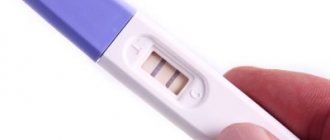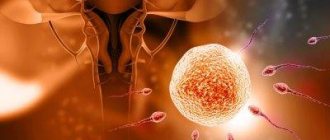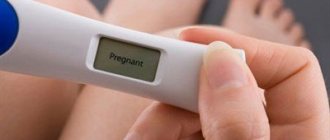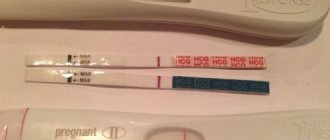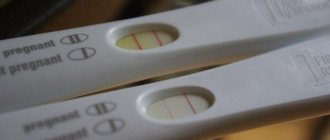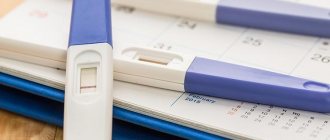Testing timing - features
In order not to waste your nerves over “empty” tests and the money that will be spent on these same tests, a woman should clearly understand that anything can be determined only if implantation takes place and the embryos take root.
The embryo after IVF does not take root immediately. For several days it is able to remain “free floating” in the uterine cavity, and only then can it attach to the endometrium. At the earliest, this will happen after two to three days; in extreme cases, no earlier than 11-12 days after the transfer. Most often, implantation after in vitro fertilization occurs on days 4-6.
If embryos at the blastocyst stage, the so-called five-day embryos, were introduced into the uterus, the chances of faster implantation are higher than when implanting “three-day embryos”. And cryotransfer can lead to longer implantation times.
After the fertilized egg attaches and penetrates into the functional layer of the woman’s reproductive organ, the chorionic villi begin to communicate with the mother’s blood vessels. From this moment on, the embryo receives everything it needs from the mother’s blood, and the chorionic villi themselves produce a special substance called hCG.
This abbreviation encodes the name of human chorionic gonadotropic hormone, which promotes the growth of the embryo in the early stages of gestation, “stimulates” and regulates the production of progesterone. And precisely: its quantitative value plays a crucial diagnostic role.
All rapid tests, which women use with such pleasure, are based on detecting an increase in the quantitative indicator of hCG in the urine. But before the hormone enters the urine, it must accumulate sufficiently in the blood plasma. That is why, immediately after implantation, even if a representative of the fair sex somehow miraculously finds out its exact date, standard and other tests will show absolutely nothing.
The amount of human chorionic gonadotropin increases in waves - every two days its amount increases approximately 2 times. Therefore, it is reasonable to carry out testing only when the real quantitative indicator of this substance reaches a sufficient value, the minimum required for recognition by existing test systems and laboratory markers during the biochemical study of a venous blood sample.
Needless to say, the required substance is detected in the plasma structures of the blood much earlier than in the urine, which is excreted due to the work of the kidneys.
Considering that implantation on average occurs only 3-6 days after transfer (DPT), the first traces of the hormone can be detected by laboratory technicians in a blood sample no earlier than 10 days after the transfer procedure. But given that with artificial insemination, implantation is often late, it is recommended to begin testing only a couple of weeks after the end of the protocol, after the procedure of implanting cultured embryos into the uterus.
Below we will justify these terms by presenting standard numerical expressions of the amount of chorionic gonadotrope after successful in vitro fertilization for each day from the embryo transfer procedure and the official end of the protocol.
How does embryo transfer occur?
The procedure for transferring embryos into the uterine cavity is the final stage of the IVF technique. It is completely painless and lasts no more than 5 minutes.
Most often, replanting is performed in the morning. To carry out the procedure, a woman needs to sit in a gynecological chair and relax. Then the doctor, using a catheter on which a tuberculin syringe is attached, will begin to inject embryos into the uterine cavity. The doctor controls all his actions using ultrasound. After the transplantation has taken place, the released catheter is examined by an embryologist: he must make sure that all prepared embryos have entered the uterus.
The success of the manipulation depends on many factors:
- Careful removal of cervical mucus;
- Viability of grown embryos;
- Catheter softness;
- Doctor's professionalism.
In special cases, a double transfer is prescribed, which is performed twice: on days 2 and 5 or on days 3 and 6 from the moment the embryos begin to develop. This procedure greatly increases the chances that the implantation will be successful. However, it is she who is sometimes the “culprit” for the occurrence of multiple or ectopic pregnancies.
Express tests: when are they acceptable?
Inexpensive and very accessible tests for identifying an “interesting position” in the form of strips with a control zone on which a reagent sensitive to hCG is applied are very convenient and quick to use. But when using them, it is extremely important to pay attention to features that are absent during conception in the traditional way (in bed, not in vitro). To begin with, you should understand and be aware that pregnancy tests for self-diagnosis were created and are being created for women who became pregnant in a completely traditional way.
If ecotransfer was performed in a stimulated in vitro fertilization protocol, during which the woman took hormones for the growth of follicles before receiving eggs, then shortly before puncture of the follicles she was administered a single dose of human chorionic gonadotropin. Traces of hCG will remain in a woman’s blood and urine for quite some time. Therefore, tests done even the next day after the transfer will show 2 stripes, which will be an absolute lie.
Women after hormonal stimulation are generally not recommended to do rapid tests, since there is a very high risk of getting a false positive result, in which there will be stripes, but pregnancy will not actually occur. After stimulation and injection of one of the human chorionic gonadotropin drugs in the protocol, it is best to conduct a laboratory blood test.
Sometimes it happens that the protocol does not include hormonal stimulation, for example, when using embryos obtained earlier and undergone cryopreservation. They can easily be replanted in a natural cycle. In this case, the use of tests is quite acceptable, but again adjusted for the very likely late implantation no earlier than 14-18 days after the transfer.
Until this point, tests may show a faint second line, which women often call a “ghost.” Although there is usually little hope for such a streak. Such illusory hope can manifest itself when using a low-quality, defective test. Often, a faintly colored, low-intensity stripe indicates that the embryo was implanted, but then it stopped growing and died. Weak “ghosts” may appear on express tests during ectopic implantation of the embryo, which after IVF, although rare, still happens.
A faintly colored control strip can be visible when the test is carried out incorrectly, the waiting limit for the result is exceeded, and when the embryo has attached late, and the quantitative hCG indicator is not yet high enough for the strip to become more brightly colored.
Usually the ghost stripe does not reassure anyone and does not convince anyone in an “interesting situation”, it only gives hope, but disappointment can be all the more painful. There is no need to worry and be so nervous for a result that cannot be considered reliable.
Tests, despite manufacturers' claims, can often give positive or negative results erroneously. Therefore, it is much easier and even cheaper (if you count all the attempts to “soak” the strips) to refuse pharmacy tests and go to the clinic to examine the level of hCG in the blood, the main thing is to do this within the time frame recommended by your attending fertility doctor.
When to take a pregnancy test after IVF
Doctors who deal with IVF issues unanimously agree that the test after embryo transfer should be done no earlier than two weeks after the procedure. By this time, all artificial hormones will “leave” the woman’s body, and home diagnostics will be reliable: the test will react to the concentration of only the hCG that is secreted by the implanted fetus.
However, women who have been pursuing their cherished goal for so long are often unable to withstand such a long period, in their opinion, and begin diagnostics in advance. Doing this most often makes no sense, but some expectant mothers claim that they saw the coveted second stripe even before the due date indicated by the doctors. Let's consider how possible such a situation is, and whether it is always true.
What result will the test show?
After embryo transfer, a pregnancy test can show three results:
- Positive;
- Weakly positive (ghost stripe);
- Negative.
Moreover, all three values can change every day after refilling. Thus, successful “five-day pregnancy” in one woman can manifest itself already on the 9th or 10th day, while in other expectant mothers a positive result will appear only on the 13th day. All these, at first glance, contradictions can be explained by the characteristics of a particular female body, as well as the speed of implantation of the embryo into the uterine cavity.
In addition, do not forget that after IVF, the test, just like during normal conception, can only respond to pregnancy at a certain concentration of hCG in the urine. Therefore, if the egg is implanted in the uterus a little later than the expected period, then the amount of the hormone has not yet reached such a level that it can be detected by the test even on the 10th day after embryo transfer. Therefore, such early diagnosis is not informative. After all, if on the 11th day after embryo transfer the test is negative, this does not exclude the appearance of a second stripe on it by the 14th knock.
Separately, you need to dwell on a weakly positive result, when on days 8-13 after the transfer the test shows a barely visible second line. This development may be due to two reasons:
The first reason is extremely dangerous, so if within a few days the faint line does not become brighter, and the woman begins to experience pain, she should immediately consult a gynecologist and undergo an ultrasound to exclude the development of the fetus outside the uterine cavity.
Can the test be wrong on days 14-16?
A pregnancy test after IVF may be wrong. Its false indicators are due to 3 reasons:
- Defective device;
- “Chemical pregnancy” (at the time of testing, the embryo tried to penetrate into the uterine cavity, but for some reason it did not succeed: conception failed);
- Due to the fact that a woman takes a lot of hormonal drugs before the IVF procedure, artificial hormones are concentrated in her body. The test reacted to them.
We have already mentioned that the results when tested at home can be considered informative only on the 14th day after replanting. If the first test is done earlier, for example, on day 12, its result requires confirmation by repeated testing or a blood test for hCG.
However, unreliable data during testing is obtained at a later date. As a result of chemical pregnancy, a positive result recorded by the test may not be obtained after laboratory tests. In this case, it would be wrong to talk about a home adaptation error: at the time of the test, the embryo was indeed ready to attach to the uterine cavity, but something interfered with it and the possible conception was interrupted.
I would like to emphasize that any result that the test showed on day 14 requires confirmation by a blood test and ultrasound diagnostics, which are carried out in a clinic.
Laboratory analysis
The stimulated IVF protocol has ended. After this, you should not immediately run to the clinic demanding to find out whether everything went well. Remember that to stimulate ovulation in the middle of the cycle, you were given an injection of human chorionic gonadotropin, which allowed the oocytes to mature faster. Because of this, the quantitative hCG indicator will be increased.
The optimal period is 14-15 days after embryo transfer.
At the end of the IVF protocol in a natural cycle, without stimulation, it is permissible to visit the clinic and go to the clinic and have a study done on the 10-11th day after embryo transfer.
After the transfer, how do hormonal levels change?
At the end of the protocol, given the unstable and rather “scattered” timing of engraftment, it is quite difficult to determine what the quantitative indicator of the hormone produced by the chorion will be if the protocol is successful. In this matter, implantation plays a decisive role - the earlier it occurred, the higher the hCG will be. However, there are average statistical standards for diagnosing an “interesting situation” based on the quantitative value of hCG in connection with the time elapsed after replanting and the age of the embryos. But in practice, the obtained values may differ.
Different medical laboratories may indicate different results; you should not expect coincidences to the number. In addition, circumstances that do not depend on the patient herself can have their say.
Chorionic gonadotropin - three-day embryos.
| DPP (day after replanting) | Age of the embryo, days | Lower threshold, mU/ml | Average value, mU/ml | Maximum threshold, mU/ml |
| 4 | 7 | 2,0 | 4,0 | 10,0 |
| 5 | 8 | 3,0 | 7,0 | 18,0 |
| 6 | 9 | 3,5 | 11,0 | 18,5 |
| 7 | 10 | 8,5 | 18,0 | 26,5 |
| 8 | 11 | 11,4 | 28,6 | 45,0 |
| 9 | 12 | 17,4 | 45,0 | 65,6 |
| 10 | 13 | 22,2 | 73,7 | 105,5 |
| 11 | 14 | 29,3 | 105,0 | 170,5 |
| 12 | 15 | 39,0 | 160,6 | 270,0 |
| 13 | 16 | 68,0 | 260,5 | 400,6 |
| 14 | 17 | 120,5 | 410,0 | 580,6 |
| 15 | 18 | 220,7 | 650,7 | 840,6 |
| 16 | 19 | 370,0 | 980,9 | 1300,4 |
| 17 | 20 | 520,6 | 1380,0 | 2000,6 |
| 18 | 21 | 750,6 | 1960,5 | 3100,6 |
| 19 | 22 | 1050,6 | 2680,0 | 4900,0 |
| 20 | 23 | 1400,6 | 3550,5 | 6200,5 |
Chronic gonadotropin – five-day embryos.
| Day after transfer | Embryo age, days | Lower limit, mU/ml | Average value, mU/ml | Maximum threshold, mU/ml |
| 2 | 7 | 2,0 | 4,0 | 10,0 |
| 3 | 8 | 3,0 | 7,0 | 18,0 |
| 4 | 9 | 3,5 | 11,0 | 18,5 |
| 5 | 10 | 8,5 | 18,0 | 26,5 |
| 6 | 11 | 11,4 | 28,6 | 45,0 |
| 7 | 12 | 17,4 | 45,0 | 65,6 |
| 8 | 13 | 22,2 | 73,7 | 105,5 |
| 9 | 14 | 29,3 | 105,0 | 170,5 |
| 10 | 15 | 39,0 | 160,6 | 270,0 |
| 11 | 16 | 68,0 | 260,5 | 400,6 |
| 12 | 17 | 120,5 | 410,0 | 580,6 |
| 13 | 18 | 220,7 | 650,7 | 840,6 |
| 14 | 19 | 370,0 | 980,9 | 1300,4 |
| 15 | 20 | 520,6 | 1380,0 | 2000,6 |
| 16 | 21 | 750,6 | 1960,5 | 3100,6 |
| 17 | 22 | 1050,6 | 2680,0 | 4900,0 |
| 18 | 23 | 1400,6 | 3550,5 | 6200,5 |
As is easy to see from the tables presented, the quantitative value of hCG will be quite sufficient to study and detect an “interesting situation” after IVF only at least 9-10 days after the transfer of cultured three-day-old embryos and on the 7th day after the introduction of five-day-old embryos into the uterus.
However, if we take into account late implantation, the results of the study may well be below the diagnostically important control level, and then the laboratory technician can determine the absence of pregnancy when it actually exists.
In order not to undermine the state of the nervous system (its safety and mental balance are more conducive to implantation and successful pregnancy), you should listen to the advice of a reproductive specialist and not try to establish the truth during the first two weeks. If everything is done correctly, the result will be 99.5% reliable in both a successful protocol and an unsuccessful one.
In addition to establishing the fact itself, a laboratory report, repeated a few days later, will make it possible to assess how the baby is growing. And if two embryos implanted, all values will exceed the normative values exactly twice.
Estradiol and progesterone levels after embryo transfer
Like progesterone, estradiol is also of great importance during embryo transfer. It must be within normal limits, otherwise the embryo simply will not be able to cling to the endometrium. This hormone is also responsible for the development of the fetal skeletal system, improves the supply of nutrients to it, and allows the muscles of the uterus to better stretch in accordance with the size of the fetus.
On the first day of transplantation, the estradiol rate is 75-225 pg/ml, and the progesterone rate is 6.9-56.6 nmol/l.
Progesterone, like estradiol, should increase daily during a successful pregnancy. There are 4 mandatory dates for testing the level of these hormones: on the day of embryo transfer, on day 3, on day 7 and on day 14.
Signs and symptoms - can you trust them?
Even specific recommendations about the timing of testing for an “interesting position” are often unable to convince women not to try to find out about the possible successful outcome of the protocol at the very beginning.
Whether the appearance of any symptoms and signs within two weeks after the embryo transfer procedure is realistic is a controversial question. From the standpoint of classical fundamental medicine, there should be no symptoms characteristic of pregnancy. Theoretically, the female body instantly responds to the accomplished implantation with metamorphoses at the hormonal level.
At first, these changes are so small that only very sensitive representatives of the fair sex can feel them. 4-5 days after implantation, slight breast swelling and changes in the sensitivity of the mammary glands are possible. This is due to an increase in the hormone prolactin, which is also a consequence of the onset of endocrine changes.
There may be no classic symptoms of toxicosis at all, and at such an insignificant stage of gestation you definitely shouldn’t expect them. But some changes may well begin within five to six days after the successful implantation of the fertilized egg into the endometrium. Therefore, some patients note that their body temperature began to rise.
Every day in the afternoon, in the evening, the temperature rises slightly above the subfebrile value of 37.0 degrees, chills are felt, or “throws you into a fever,” your face may turn red and your cheeks may burn.
Quite often at this stage, women think that they are sick or have a cold. This impression is complemented by a slight runny nose. It is not associated with colds or viruses, but with the effect of progesterone, which becomes more abundant after implantation, on the mucous membranes. Under the influence of this female hormone, they become more loose and swollen.
There is no need to treat a runny nose like this, it is physiological rhinitis of pregnant women. However, all signs and symptoms cannot be considered reliable or clinically important. The only reliable information is the results of a blood test for human chorionic gonadotropin.
HCG dynamics
One of the most reliable methods for detecting not only the presence of pregnancy, but also its duration is the determination of human chorionic gonadotropin in a woman’s blood.
Since normally the production of the hormone and the increase in its level occurs only during pregnancy, this method can show its onset at the earliest stages, while all other methods make the woman wait.
In a non-pregnant woman, the hCG level is between 0 and 5 mIU/L. Test strips can show pregnancy at hormone levels of 10 to 25 mIU/L, and an ultrasound will show the fetus when hCG reaches 1000 mIU/L.
The physiological onset and course of pregnancy requires less control of hormone levels, while monitoring the dynamics of hCG after IVF is necessary to identify normal implantation of embryos and their development.
The level of hCG in the blood with the onset of pregnancy undergoes significant fluctuations daily and weekly. Below is a table showing the increase in hormone levels depending on the gestational age during IVF.
Gestation period from conception (in weeks) HCG level (in mIU/l)
| 1 — 2 | 25 – 156 |
| 2 – 3 | 101 – 4 870 |
| 3 – 4 | 1 110 – 31 500 |
| 4 – 5 | 2 560 – 82 300 |
| 5 – 6 | 23 100 – 141 000 |
| 6 – 7 | 27 300 – 233 000 |
| 7 – 11 | 20 900 – 291 000 |
| 11 – 16 | 6 140 – 103 000 |
| 16 – 21 | 4 720 – 80 100 |
| 21 — 39 | 2 700 – 78 100 |
Monitoring the dynamics of the increase in hCG levels after IVF is necessary to monitor the correct development of pregnancy. Depending on her term, significant fluctuations in the level of the hormone in the blood of the expectant mother occur.
Features of in vitro fertilization
In vitro fertilization is a modern reproductive technology that is used for infertility.
During the procedure, an oocyte is removed from the ovaries and fertilized under “in vitro” conditions. After this, the diploid cell is cultivated in a special incubator for 3-5 days. The reproductive specialist decides at what point to transfer the embryo into the uterus, focusing on the degree of preparedness of the endometrium for implantation. It is believed that five-day-old embryos take root better, but not all fertilized oocytes can survive to transfer at the appointed time.
What else do you need to know?
With the advent of in vitro fertilization (IVF), including cryotransfer of embryos, infertility has ceased to be a death sentence. Today, many families find happiness thanks to IVF.
The embryo cryotransfer procedure means the introduction of 1 to 3 embryos into the uterus. This implementation is carried out using a special catheter, always under sterile conditions. The transfer process is controlled by an ultrasound machine.
Women are often wary of this procedure. Although it is absolutely safe and even if unsuccessful, it will not harm the woman’s health. So it can be repeated again.
Cryopernos has a number of advantages:
- high probability of having a healthy child. All embryos undergo a thorough examination before cryopreservation;
- a man is not required to specifically donate sperm for fertilization.
The only disadvantage is the use of special hormonal drugs that simulate natural fertilization.
HCG analysis - rules for delivery
The concentration of hormones in the body of the expectant mother is determined by collecting venous blood. Reproductologists recommend taking tests in the morning on an empty stomach - at least 8-9 hours should pass between the last meal and blood donation. If a woman is taking over-the-counter medications, she should tell her doctor a few days before the tests.
Enzyme immunoassay must be performed not only to determine gestation. The hCG test should also be taken in the 2nd trimester of pregnancy in order to identify defects in the development of the child. Correction of maintenance therapy can prevent up to 25% of congenital pathologies and anomalies.
After embryo implantation
After the embryo is transferred, the life of the expectant mother changes greatly. This creates new restrictions and recommendations that must be followed. It is important to follow all this in order to get the planned result after completing the protocol.
On the day of the embryo transfer, you cannot shower. In this case, preference should be given to a measured, calm pace of life, where there is time for proper rest. It is forbidden to lift weights, refuse sex and clothes that rub and hinder movement. Otherwise, optimal blood circulation in the pelvic area is disrupted. You should treat yourself with special trepidation and care in the first days after fertilization.
The following measures must be observed:
- Create all the conditions for good sleep, which will last at least 8 hours.
- Don’t forget about walking – it should be done no more than 3 times a day.
- Be sure to exclude unhealthy, high-calorie foods from your diet, and replace them with healthy natural products that contain many vitamins and microelements.
- Drink plenty of clean water.
- It is better not to visit places where there are a lot of people. This is necessary to avoid possible infection.
After the embryo is implanted, for a couple of weeks the woman may not feel her new position or the changes occurring in the body. But this does not mean that pregnancy has not occurred. A reliable result will be demonstrated by a blood test. It should be taken 2 weeks after implantation.
Stages of embryo development
Cryotransfer is one of the types of IVF, which can be used when healthy eggs (more than 4) mature. Depending on the situation, a woman can be implanted with 1 to 4 eggs. The remaining material can be frozen and stored for about 20 years.
An important condition for a successful pregnancy after the cryotransfer procedure is the absence of stress and other emotional disorders in the patient.
Fertilization of the egg occurs outside the woman's body. First, the cell goes through the zygote stage (first 12-16 hours) with a double set of chromosomes. On the second day, embryonic cells begin dividing into blastomeres. Only on the fifth day after fertilization is the egg completely suitable for replantation
The stages of embryo development can be divided by days after the cryotransfer procedure.
- first day - the embryo develops and gradually grows;
- second day – blastocyst stage;
- third day - the blastocyst emerges from its shell;
- fourth day - attachment of the blastocyst to the wall of the uterus;
- fifth, sixth days - introduction of the formed morula into the uterine wall;
- seventh day – formation of embryonic and placental cells;
- the eighth day - the beginning of the production of human chorionic gonadotropin (pregnancy hormone);
- eleventh day - thanks to the increase in the hCG level, it can be detected using tests and pregnancy can be accurately determined.
Embryo development in the first 7 days
There are cases when pregnancy does not occur after cryotransfer and the embryos do not take root. The most common causes are changes in the structure of the uterine mucosa or undetected diseases.
Therefore, before the IVF procedure, it is recommended to undergo the necessary examinations and hormonal therapy . In order for the embryo to be implanted successfully, it is also necessary to calculate a favorable day, depending on the woman’s menstrual cycle. Next, the procedure for transferring 5 and 3 day embryos begins, depending on the patient’s health and the number of such procedures.
How to recognize pregnancy (indirect symptoms)
If any of the listed symptoms are obvious and create discomfort, you should consult a doctor. This is necessary to exclude the possibility of miscarriage.
There are those women who, a few days after implantation, experience the following symptoms that indicate pregnancy:
- swelling, pain in the mammary glands;
- vomiting, nausea, weakness of the whole body. During pregnancy with the help of IVF, such symptoms are more pronounced. This occurs as a result of taking hormonal drugs;
- constant urge to urinate;
- no menstruation;
- discomfort in the abdomen, aching pain in the lumbar area.
Primary signs of pregnancy after IVF
Vaginal discharge has acquired a thick structure and white color. This is due to the fact that blood circulation in the uterus has increased. If the discharge is abundant, then in this case you should consult a doctor. This is necessary because there is a possibility of developing an unfavorable environment.
But these signs may be the result of other reasons. For example, they arise due to an increased dose of hormonal drugs prescribed to a woman when she was preparing for IVF. There are cases where overly emotional women have exhibited similar symptoms. But in this case they arise due to nervousness. You need to be patient and monitor your own condition.
Other ways to determine pregnancy after IVF
The essence of IVF is that a viable egg appears in a woman’s ovaries, which can safely implant in the uterine cavity and begin to develop, turning into an embryo. That is, to help the female body begin to function in the “natural” mode of conception. Therefore, pregnancy can be determined after IVF in the same ways as during conventional fertilization.
These methods include home pregnancy tests, which we discussed above, and laboratory blood tests for hCG levels. The last diagnosis is considered the most informative, since its reliability reaches 99.9%.
- Careful removal of cervical mucus;
- Viability of grown embryos;
- Catheter softness;
- Doctor's professionalism.
